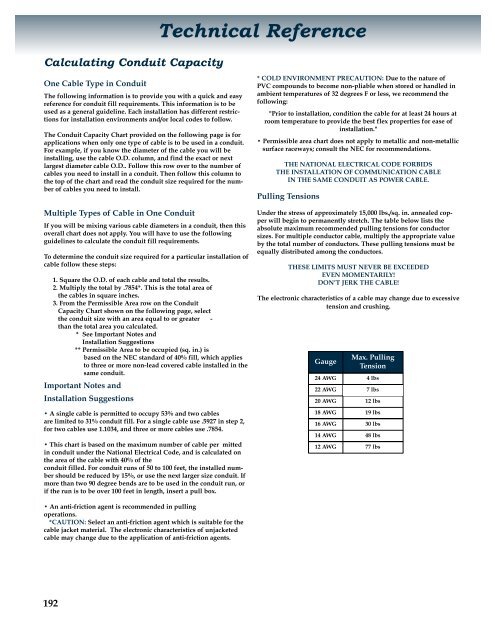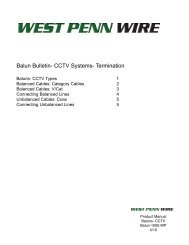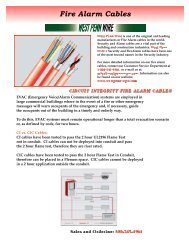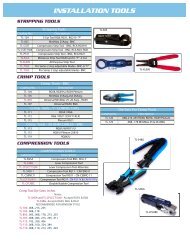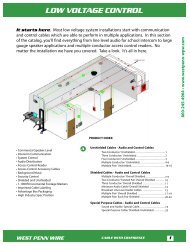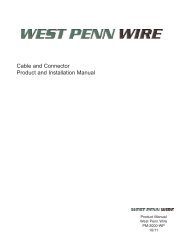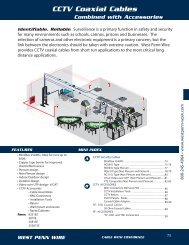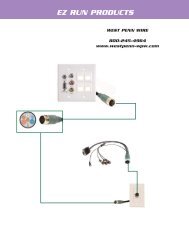Create successful ePaper yourself
Turn your PDF publications into a flip-book with our unique Google optimized e-Paper software.
Calculating Conduit Capacity<br />
One Cable Type in Conduit<br />
The following information is to provide you with a quick and easy<br />
reference for conduit fill requirements. This information is to be<br />
used as a general guideline. Each installation has different restrictions<br />
for installation environments and/or local codes to follow.<br />
The Conduit Capacity Chart provided on the following page is for<br />
applications when only one type of cable is to be used in a conduit.<br />
For example, if you know the diameter of the cable you will be<br />
installing, use the cable O.D. column, and find the exact or next<br />
largest diameter cable O.D.. Follow this row over to the number of<br />
cables you need to install in a conduit. Then follow this column to<br />
the top of the chart and read the conduit size required for the number<br />
of cables you need to install.<br />
Multiple Types of Cable in One Conduit<br />
If you will be mixing various cable diameters in a conduit, then this<br />
overall chart does not apply. You will have to use the following<br />
guidelines to calculate the conduit fill requirements.<br />
To determine the conduit size required for a particular installation of<br />
cable follow these steps:<br />
1. Square the O.D. of each cable and total the results.<br />
2. Multiply the total by .7854*. This is the total area of<br />
the cables in square inches.<br />
3. From the Permissible Area row on the Conduit<br />
Capacity Chart shown on the following page, select<br />
the conduit size with an area equal to or greater -<br />
than the total area you calculated.<br />
* See Important Notes and<br />
Installation Suggestions<br />
** Permissible Area to be occupied (sq. in.) is<br />
based on the NEC standard of 40% fill, which applies<br />
to three or more non-lead covered cable installed in the<br />
same conduit.<br />
Important Notes and<br />
Installation Suggestions<br />
• A single cable is permitted to occupy 53% and two cables<br />
are limited to 31% conduit fill. For a single cable use .5927 in step 2,<br />
for two cables use 1.1034, and three or more cables use .7854.<br />
• This chart is based on the maximum number of cable per mitted<br />
in conduit under the National Electrical Code, and is calculated on<br />
the area of the cable with 40% of the<br />
conduit filled. For conduit runs of 50 to 100 feet, the installed number<br />
should be reduced by 15%, or use the next larger size conduit. If<br />
more than two 90 degree bends are to be used in the conduit run, or<br />
if the run is to be over 100 feet in length, insert a pull box.<br />
• An anti-friction agent is recommended in pulling<br />
operations.<br />
*CAUTION: Select an anti-friction agent which is suitable for the<br />
cable jacket material. The electronic characteristics of unjacketed<br />
cable may change due to the application of anti-friction agents.<br />
192<br />
Technical Reference<br />
* COLD ENVIRONMENT PRECAUTION: Due to the nature of<br />
PVC compounds to become non-pliable when stored or handled in<br />
ambient temperatures of 32 degrees F or less, we recommend the<br />
following:<br />
"Prior to installation, condition the cable for at least 24 hours at<br />
room temperature to provide the best flex properties for ease of<br />
installation."<br />
• Permissible area chart does not apply to metallic and non-metallic<br />
surface raceways; consult the NEC for recommendations.<br />
THE NATIONAL ELECTRICAL CODE FORBIDS<br />
THE INSTALLATION OF COMMUNICATION CABLE<br />
IN THE SAME CONDUIT AS POWER CABLE.<br />
Pulling Tensions<br />
Under the stress of approximately 15,000 lbs./sq. in. annealed copper<br />
will begin to permanently stretch. The table below lists the<br />
absolute maximum recommended pulling tensions for conductor<br />
sizes. For multiple conductor cable, multiply the appropriate value<br />
by the total number of conductors. These pulling tensions must be<br />
equally distributed among the conductors.<br />
THESE LIMITS MUST NEVER BE EXCEEDED<br />
EVEN MOMENTARILY!<br />
DON’T JERK THE CABLE!<br />
The electronic characteristics of a cable may change due to excessive<br />
tension and crushing.<br />
Gauge<br />
12 AWG<br />
Max. Pulling<br />
Tension<br />
24 AWG 4 lbs<br />
22 AWG<br />
7 lbs<br />
20 AWG 12 lbs<br />
18 AWG 19 lbs<br />
16 AWG 30 lbs<br />
14 AWG 48 lbs<br />
77 lbs


